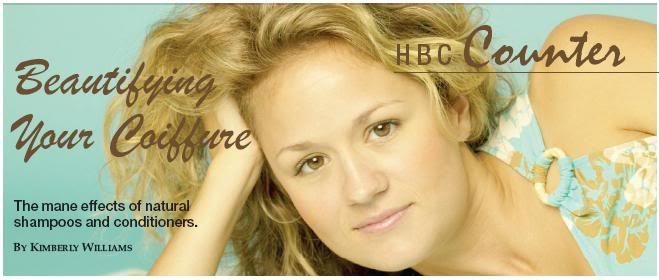Conventional wisdom may dictate that ingredients in shampoos and conditioners are more or less the same. Well, think again. Just as hair types vary, so do ingredients, leaving shoppers with thousands of options from which to choose. Shampoo and conditioner should clean, give hair a fresh smell and moisturize the scalp, but harsh chemicals in traditional products can wick away hair’s natural oils, giving way to dull, lifeless locks. Confused about which ingredients in shampoo and conditioner are best to offer in your store? Lucky for you, we have all the bases covered.
Mane Ingredients
To clench a spot as a top seller, shampoos and conditioners must have finely detailed packaging, feel thick and creamy to the touch, create a frothy lather and be reasonably priced. The U.S. Department of Agriculture (USDA) lacks the authority and standards to regulate organic personal care product labels (1), but there are ways to set apart truly natural and organic beauty care products from the rest. Several industry groups such as the Natural Products Association and Oasis have formulated standards for natural and personal care, respectively. Member companies that follow their rigorous standards may use the groups’ logos on their bottles, giving shoppers the cue that the products are legit.
Carefully read the labels of all personal care products that claim to be natural or organic, because many, in fact, are not. Notes Samuel Epstein, chairman of the Chicago-based Cancer Prevention Coalition, “There may be companies who throw in one or two organic ingredients among petrochemicals and then label the whole product organic” (2).
Nonetheless, it is important for shoppers to be able to choose shampoos and conditioners made with all-natural or organic ingredients. Opting for traditional brands can be harmful because the hair, scalp and skin all have the ability to absorb the chemicals and toxins that are present in these products (1). “Consumers have got to be fully aware of the fact that mainstream industry products carry a wide range of ingredients that are carcinogenic or allergenic,” adds Epstein (2).
Traditional products may prove to be harmful to other areas of the body as well. Researchers from the National Institutes of Health have established a link between an ingredient in shampoo (methylisothiazoline) and nervous system damage. “The experiments were conducted with the brain cells of rats and they show that contact with this ingredient called methylisothiazoline, or MIT, causes neurological damage” (3). MIT poses health risks because it inhibits communication between neurons, eventually slowing them down. This is just one example of harmful ingredients present in traditional hair care products. That being said; let’s explore some common natural hair care ingredients.
Hair and Scalp Essentials
Niacin. Niacin is a component of the vitamin B-3 complex and is commonly found in meat and yeast. It is used in shampoos and conditioners because it stimulates follicles, which in turn accentuates the hair’s look and feel. Niacin increases the hair’s suppleness by improving the texture, which may have become damaged during chemical processing (4).
Silica. Men and women alike spend tons of time and money trying to turn their lack-luster hair into shiny locks. Using silica-based conditioners may help. Silica strengthens the scalp, preventing the hair from becoming brittle and susceptible to split ends (5). It is also said to improve the hair’s volume in those who experience thinning hair.
Chamomile (Chamomilla recutita). Chamomile is a plant best known for its anti-inflammatory, anti-allergenic, anti-microbial, antiseptic and astringent qualities (6). It is used to treat dry hair and scalp because of its hydrating and emollient properties. Chamomile’s active ingredient is alpha-bisabolol (a myrrh-type gum resin that contains anti-irritant properties). A popular ingredient in hair dyes, chamomile also has brightening and shine-enhancing attributes, which are particularly beneficial for blond hair (6).
Natural surfactants. These substances decrease tension between cleansing ingredients, enabling them to spread more easily and create cleansing suds. Natural surfactants are often made from vegetable-based oils. A few of these oils include avocado, coconut, grapeseed, jojoba, olive and palm kernel (6).
Lavender (Lavandula officinalis). Besides having a calming scent, this flower has several cleansing and astringent properties. It is said to help regenerate skin cells and is adaptogenic in nature because it normalizes dry and oily scalp and hair. To lavender’s credit, it is also anti-inflammatory, anti-microbial and is great for sensitive or mature skin types (6).
Biotin. Evidence suggests that biotin can rejuvenate brittle, splitting or thinning hair. This vitamin is considered part of the B-complex group of vitamins, making it an essential component for healthy eyes, hair, liver and skin. In fact, biotin is so effective that it is used along with zinc and other ingredients to fight alopecia in adults and children (7).
Last, tea tree oil is commonly found in anti-dandruff formulas. This essential is said to have powerful antiseptic and germicidal properties (8).
This is only a smattering of the many available efficacious haircare ingredients. Others include proteins, vitamins A/E, titanium dioxide (for sun protection) aloe and more. WF
References
1. J. Leland, “Is Organic Shampoo Chemistry or Botany?” The New York Times, May 18, 2003.
2. “Up Close and Personal,” Better Nutrition, October 1, 2003.
3. M. Adams, “Popular Shampoos Contain Toxic Chemicals Linked to Nerve Damage,” www.naturalnews.com/003210.html, accessed April 16, 2009.
4. Cosmeticsinfo.org, www.cosmeticsinfo.org/ingredient_details.php?ingredient_id=305, accessed April 15, 2009.
5. “Beautiful Hair Comes from within with Silica,” www.articlestreet.com/pdf/article-45990.pdf, accessed April 20, 2009.
6. M.B. Janssen, Naturally Healthy Hair (Storey Books, North Adams, MA, 1999).
7. University of Maryland Medical Center, www.umm.edu/altmed/articles/vitamin-h-000342.htm, accessed April 21, 2009.
8. A. Hampton, Natural Ingredients Dictionary (Organica Press, Tampa, FL, 2006).
Published in WholeFoods Magazine, July 2009









